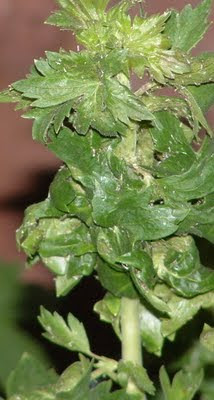
Sunday, October 16, 2011
Saturday, October 1, 2011
Edible and Ecological Landscaping


Saturday, June 18, 2011
Release the Ladybugs!
 I was actually excited to see the currant bush covered in aphids; these tiny green bugs were the perfect excuse to buy the $9.99 bag of ladybugs.
I was actually excited to see the currant bush covered in aphids; these tiny green bugs were the perfect excuse to buy the $9.99 bag of ladybugs. The kids were ecstatic!
The kids were ecstatic!
The June Bloomers
Saturday, June 4, 2011
Crab Apples
These are the real crab apples with the golf ball sized fruit that rot on the walkaway and make a terrible mess. Are these trees worth all the maintenance? Right now have to say yes!
Wednesday, June 1, 2011
Edible Plants-Basil

Thursday, May 26, 2011
Tuesday, May 10, 2011
Ikea Pots and Mother's Day Plantings
 On a recent visit to Ikea, I spotted these metal, blue planters and had to purchase them for my back cement slab, or more lovingly referred to as the back patio. Most of Ikea's planters, however, do not have drainage holes so I recruited my trusty husband and his drill to make my containers more plant friendly.
On a recent visit to Ikea, I spotted these metal, blue planters and had to purchase them for my back cement slab, or more lovingly referred to as the back patio. Most of Ikea's planters, however, do not have drainage holes so I recruited my trusty husband and his drill to make my containers more plant friendly.



Here are my extra tomato seedlings from the greenhouse. I obviously sowed too many seeds; this flat represents my bounty after I transplanted around thirty seedlings in 4 1/2" pots. A rule of thumb is to transplant flats of germinated seeds after their first true leaves appear. The first leaves you will notice on a germinating seedling are referred to as the cotyledons while the next set of leaves are known as the true leaves.
Sunday, April 24, 2011
Tuesday, April 12, 2011
Chickens Attack!
Thursday, February 24, 2011
Vegetable Garden Planting Chart for Salt Lake City
Hardy Vegetables--Plant between March 15th and May 1st
Broccoli,Cabbage,Kohlrabi, Peas(through May 15th),Radish, Spinach, Turnip
Semi-Hardy (Plant 2 weeks after planting hardy vegetables) March 20th-May 1st
Salsify, Lettuce, Endive
Tender-Around May 5th
Sweet Corn, Cucumbers, Eggplant
Very Tender--May 20 to June 10
Tomato, Watermelon, Pepper, Lima Bean
Fall Harvest--July 1 to August 1
Lettuce, Spinach,Kale
Seed List

Tomatoes
Riesentraube--an old German heirloom meaning "Giant bunch of Grapes"
Pineapple--very large, up to 2 lbs each. The yellow fruit has red marbling through the flesh with a sweet and fruity flavor.
Black from Tula--a rich, deep purplish brown tomato with a rich, sweet and spicy flavor.
Pink Brandywine--large fruit with superb flavor, a potato-leafed variety from 1885.
Peppers
Golden Cal Wonder
Red Mini Bell
Lettuce Mixes
European Muclun Salad
Rocky Top Mix
Radicchio
Casrelfranco "Libra"
Carrots
Parisienne-Small round carrots, that are fairly uniform
Cucumbers
Mexican Sour Gherkin--small cucumber-like fruit are shaped like baby watermelons
Melon
Minnesota Midget
Saturday, January 22, 2011
Since it is so Cold and Dreary...
Saturday, January 1, 2011
Gardening Goals for 2011
My goal this year is to get my yard looking decent and in the process grow some yummy food for my family. So here are my goals in no particular order;
1. Build a pole bean tepee like the one picture here:

The tepee also serves as a hideout for the little ones. Not sure where I'm going to put the hideout yet, but I want to grow one of these!
2. Build 6 raised beds.
3. Start cool season crops on time by using hoops. Traditional radishes take 25 days from seed to harvest so I have no excuse but to get these babies planted and harvested!
4. Follow with the warm season crops. I plan to get my seeds from Baker Creek Heirloom Seeds. This company has the most beautiful seed catalogue ever. You've got to order one.
5. Finish the chicken coop by building a living roof and planting grapes along the south side of the run. Here is an example: Not exactly what I plan, but it is cute.
Not exactly what I plan, but it is cute.
And here is what I wish the coop would look like when I am done. This gardening/homesteading adventure, however, is an undertaking with extremely limited funds so I will be grateful for my coop made from scavenged, I mean recycled, materials.
This gardening/homesteading adventure, however, is an undertaking with extremely limited funds so I will be grateful for my coop made from scavenged, I mean recycled, materials.
6. Have a killer compost pile.
7. Install at least one rain barrel.
8. Plant at least one fruit tree ( two, if I need a pollinator).
The yard needs much more work than the above goals cover, but I think this will be a good start for my time and money constrained gardening budget. Wish me luck and happy gardening in 2011!

































